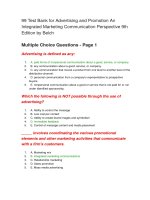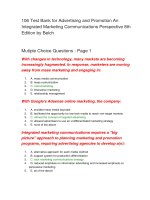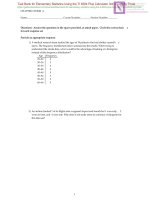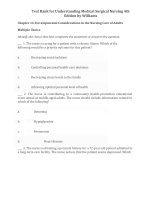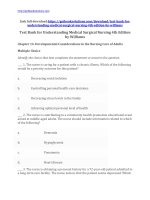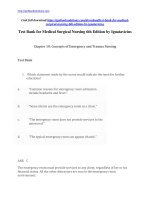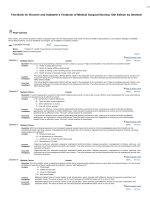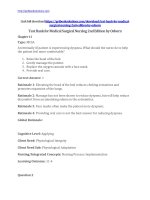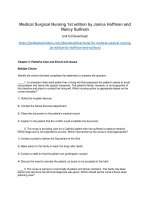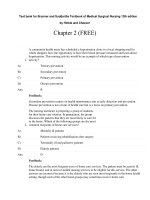Download test bank for brunner and suddarths textbook of medical surgical nursing 12th edition by smeltzer
Bạn đang xem bản rút gọn của tài liệu. Xem và tải ngay bản đầy đủ của tài liệu tại đây (549.26 KB, 8 trang )
1 of 8
TEST BANK > CONTROL PANEL > POOL MANAGER > POOL CANVAS
Test
for Brunner
andBank
Suddarth's
Textbook
ofSuddarth's
Medical Surgical
Nursing
Edition
by Smeltzer
This
is Bank
download
full: Test
for Brunner
and
Textbook
of 12th
Medical
Surgical
Nursing 12th Edition by Smeltzer
CLICK HERE
Pool Canvas
Add, modify, and remove questions. Select a question type from the Add Question drop-down list and click Go to add questions. Use Creation Settings to establish
which default options, such as feedback and images, are available for question creation.
Add
Creation Settings
Name
Chapter 01: Health Care Delivery and Nursing Practice
Description Diploma exported pool
Instructions
Modify
Add Question Here
Multiple Choice
1 points
Modify
Remove
Question The school nurse is presenting a health promotion class to a group of high school students. How does the nurse define health?
Answer
A. Health is being disease free.
B. Health is having fulfilling relationships.
C. Health is having a clean drinking source and nutritious food.
D. Health is being connected in body, mind, and spirit.
Correct
Feedback
The World Health Organization (WHO) defines health in the preamble to its constitution as a “state of complete physical, mental, and
social well-being and not merely the absence of disease and infirmity.” The other answers are incorrect because they are not how
WHO defines health.
Incorrect
Feedback
The World Health Organization (WHO) defines health in the preamble to its constitution as a “state of complete physical, mental, and
social well-being and not merely the absence of disease and infirmity.” The other answers are incorrect because they are not how
WHO defines health.
Add Question Here
Multiple Choice
1 points
Modify
Remove
Question A nurse is speaking to a group of high school students about what it is like to be a nurse. What is one characteristic the nurse would cite as
necessary to possess to be an effective nurse?
Answer
A. Sensitivity to cultural differences
B. Team-focused nursing approach
C. Strict adherence to routine
D. One set cultural practice
Correct
Feedback
To promote an effective nurse–patient relationship and positive outcomes of care, nursing care must be culturally competent,
appropriate, and sensitive to cultural differences. Team-focused nursing and strict adherence to routine are not characteristics
needed to be an effective nurse. “One set” cultural practice is nonexistent.
Incorrect
Feedback
To promote an effective nurse–patient relationship and positive outcomes of care, nursing care must be culturally competent,
appropriate, and sensitive to cultural differences. Team-focused nursing and strict adherence to routine are not characteristics
needed to be an effective nurse. “One set” cultural practice is nonexistent.
Add Question Here
Multiple Choice
1 points
Modify
Remove
Question With the changing population and increased longevity, people have had to become more knowledgeable about their health and the
professional health care they receive. A development that has been born of this trend is organized self-care education programs. What is one thing
these programs emphasize?
Answer
A. Good prenatal care
B. An abundance of information
C. Judicious use of internet self-help groups
D. Management of illness
Correct
Feedback
Organized self-care education programs emphasize health promotion, disease prevention, management of illness, self-care, and
judicious use of the professional health care system. The other answers are incorrect because they are not emphasized by self-care
education programs.
Incorrect
Feedback
Organized self-care education programs emphasize health promotion, disease prevention, management of illness, self-care, and
judicious use of the professional health care system. The other answers are incorrect because they are not emphasized by self-care
education programs.
Add Question Here
Multiple Choice
1 points
Modify
Remove
Question The home health nurse is assisting a patient and his family in planning the patient's return to work after an extensive illness. On which level
of Maslow's hierarchy of basic needs does the patient's need for self-fulfillment fit?
Answer
A. Physiologic
B. Safety and security
C. Love and belonging
D. Self-actualization
Correct
Feedback
Maslow's highest level of human needs is self-actualization, which includes self-fulfillment, desire to know and understand, and
aesthetic needs. The other answers are incorrect because self-fulfillment does not fit on any of them.
Incorrect
Feedback
Maslow's highest level of human needs is self-actualization, which includes self-fulfillment, desire to know and understand, and
aesthetic needs. The other answers are incorrect because self-fulfillment does not fit on any of them.
Add Question Here
Modify
Remove
2 of 8
Multiple Choice
1 points
Question The view that health and illness are not static states but lie on a continuum is not just a nursing concept; it runs throughout the professional
health care system. What does this view aid the nurse in understanding?
Answer
A. That care should focus on the treatment of disease
B. That a person's state of health is ever changing
C. That a person does not have varying degrees of illness
Correct
Feedback
Incorrect
Feedback
D. That care should focus on the patient's response to medications
By viewing health and illness on a continuum, it is possible to consider a person as being neither completely healthy nor completely ill.
Instead, a person's state of health is ever-changing and has the potential to range from high-level wellness to extremely poor health and
imminent death. The other answers are incorrect because patient care should not focus just on the treatment of disease, people do have
varying degrees of illness, and care should not focus on the response to medications but on the patient's response to all aspects of nursing
care.
By viewing health and illness on a continuum, it is possible to consider a person as being neither completely healthy nor completely ill.
Instead, a person's state of health is ever-changing and has the potential to range from high-level wellness to extremely poor health and
imminent death. The other answers are incorrect because patient care should not focus just on the treatment of disease, people do have
varying degrees of illness, and care should not focus on the response to medications but on the patient's response to all aspects of nursing
care.
Add Question Here
Multiple Choice
1 points
Question What does the nurse, working in a community health clinic, teach about disease prevention?
Answer
Modify
Remove
A. That it is best achieved through attending self-help groups
B. That it is best achieved by taking yearly physicals
C. That it is best achieved by being an active participant in the community
D. That it is best achieved by exhibiting behaviors that promote health
Correct
Feedback
Incorrect
Feedback
Today, increasing emphasis is placed on health, health promotion, wellness, and self-care. Health is seen as resulting from a lifestyle
oriented toward wellness. The other answers are incorrect because nurses in community health clinics do not teach that disease
prevention is best achieved through attending self-help groups, or by taking yearly physicals or by being an active participant in the
community.
Today, increasing emphasis is placed on health, health promotion, wellness, and self-care. Health is seen as resulting from a lifestyle
oriented toward wellness. The other answers are incorrect because nurses in community health clinics do not teach that disease
prevention is best achieved through attending self-help groups, or by taking yearly physicals or by being an active participant in the
community.
Add Question Here
Multiple Choice
1 points
Modify
Remove
Question A nurse on a medical-surgical unit has asked to represent her unit on the hospital's Continuous Quality Improvement (CQI) committee. In
researching CQI programs, what has the nurse found?
Answer
A. CQI programs establish accountability on the part of health care professionals.
B. CQI programs focus on the process used to provide care.
C. CQI programs identify incidents rather than processes.
D. CQI programs justify health care costs.
Correct
Feedback
Incorrect
Feedback
Unlike QA, which focuses on individual incidents or errors and minimal expectations, CQI focuses on the processes used to provide
care, with the aim of improving quality by assessing and improving those processes that most affect patient care outcomes and patient
satisfaction. The other answers are incorrect because CQI programs do not focus on the accountability of the health care professionals,
they do not identify incidents rather than processes, and they do not justify health care costs.
Unlike QA, which focuses on individual incidents or errors and minimal expectations, CQI focuses on the processes used to provide
care, with the aim of improving quality by assessing and improving those processes that most affect patient care outcomes and patient
satisfaction. The other answers are incorrect because CQI programs do not focus on the accountability of the health care professionals,
they do not identify incidents rather than processes, and they do not justify health care costs.
Add Question Here
Multiple Choice
1 points
Modify
Remove
Question Because of managed health care there have been many significant changes in the health care delivery system. What is one major effect
managed health care has had on the patient population?
Answer
A. Patients are in the hospital for a longer period of time.
B. Patients are locked into prenegotiated payment rates that have remained unchanged.
C. Patients with high home-care needs are being discharged into the community.
D. Patient use of ambulatory care has decreased.
Correct
Feedback
Incorrect
Feedback
Managed care has contributed to a dramatic reduction in inpatient hospital days, continuing expansion of ambulatory care, fierce
competition, and marketing strategies that appeal to consumers as well as to insurers and regulators. It has also resulted in patients
returning to the community with more health care needs, many of which are complex. The other answers are incorrect because
patients are not in the hospital for longer periods of time; patients are not locked into payment rates that have remained unchanged;
and patient use of ambulatory care has not decreased, it has increased.
Managed care has contributed to a dramatic reduction in inpatient hospital days, continuing expansion of ambulatory care, fierce
competition, and marketing strategies that appeal to consumers as well as to insurers and regulators. It has also resulted in patients
returning to the community with more health care needs, many of which are complex. The other answers are incorrect because
patients are not in the hospital for longer periods of time; patients are not locked into payment rates that have remained unchanged;
and patient use of ambulatory care has not decreased, it has increased.
Add Question Here
Multiple Choice
1 points
Modify
Remove
Question You are the nurse admitting a patient to your unit. What is your most important nursing function at this time?
Answer
A. Identifying the immediate needs of the patient
B. Checking the admitting physician's orders
C. Obtaining a baseline set of vital signs
D. Allowing the family to be with the patient
Correct
Feedback
Among the nurse's important functions in health care delivery, identifying the patient's immediate needs and working in concert with
the patient to address them is most important. The other nursing functions are important, but they are not the most important
function.
Incorrect
Feedback
Among the nurse's important functions in health care delivery, identifying the patient's immediate needs and working in concert with
the patient to address them is most important. The other nursing functions are important, but they are not the most important
function.
3 of 8
Add Question Here
Multiple Choice
1 points
Modify
Remove
Question Many institutions use clinical pathways to direct patient care for certain diagnosis-related groups (DRGs). When a nurse gives care based
on a clinical pathway, she knows that to achieve the desired outcomes specific care must be given within what?
Answer
A. The designated time frame of the clinical pathway
B. The auspices of the nurse manager of the unit
C. The modifications made by that specific care unit
D. The timeframe designated by the nurse initiating the clinical pathway
Correct
Feedback
The pathways indicate key events, such as diagnostic tests, treatments, activities, medications, consultation, and education, that must
occur within specified times for patients to achieve the desired and timely outcomes. The other answers are incorrect because care is
not given within the auspices of the units nurse manager, and a clinical pathway is not modified from one unit to another, nor is it
modified by the nurse initiating the pathway.
Incorrect
Feedback
The pathways indicate key events, such as diagnostic tests, treatments, activities, medications, consultation, and education, that must
occur within specified times for patients to achieve the desired and timely outcomes. The other answers are incorrect because care is
not given within the auspices of the units nurse manager, and a clinical pathway is not modified from one unit to another, nor is it
modified by the nurse initiating the pathway.
Add Question Here
Multiple Choice
1 points
Modify
Remove
Question Staff nurses in an ICU setting have noticed that their patients required fewer interventions for pain when the ICU was quiet. They passed
their observations on to a nurse researcher and asked the researcher to design a study about the effects of noise on the pain levels of hospitalized
patients. How does this demonstrate the primary purpose of nursing research?
Answer
A. Nursing research involves patients and their care while hospitalized.
B. Nursing research contributes to the scientific base of nursing practice.
C. Nursing research draws conclusions about the quality of patient care.
D. Nursing research explains ongoing medical studies to patients.
Correct
Feedback
Incorrect
Feedback
The primary task of nursing research is to contribute to the scientific base of nursing practice. Studies are needed to determine the
effectiveness of nursing interventions and nursing care. The science of nursing grows through research, leading to the generation of
scientifically based rationale for nursing practice and patient care. The other answers are incorrect because they are not the primary
purpose of nursing research.
The primary task of nursing research is to contribute to the scientific base of nursing practice. Studies are needed to determine the
effectiveness of nursing interventions and nursing care. The science of nursing grows through research, leading to the generation of
scientifically based rationale for nursing practice and patient care. The other answers are incorrect because they are not the primary
purpose of nursing research.
Add Question Here
Multiple Choice
1 points
Modify
Remove
Question Nurses now have the option to practice in a variety of settings. One of the fastest growing venues of practice for the nurse in today's health
care environment is home health care. What is the basis for the growth in this health care setting?
Answer
A. The chronic nursing shortage
B. The focus on treatment of disease
C. The preference of nurses to work during the day instead of evening or night shifts
D. The discharge of patients who are more critically ill
Correct
Feedback
With shorter hospital stays and increased use of outpatient health care services, more nursing care is provided in the home and
community setting. The other answers are incorrect because they are not the basis for the growth in nursing care delivered in the
home setting.
Incorrect
Feedback
With shorter hospital stays and increased use of outpatient health care services, more nursing care is provided in the home and
community setting. The other answers are incorrect because they are not the basis for the growth in nursing care delivered in the
home setting.
Add Question Here
Multiple Choice
1 points
Modify
Remove
Question Nurses have different educational backgrounds and function under many titles in their practice setting. If a nurse were practicing in an
oncology clinic and her role included clinical practice, education, management, consultation, and research, what would most accurately describe this
nurse's title?
Answer
A. Midwife
B. Clinical nurse specialist
C. Nurse manager
D. Staff nurse
Correct
Feedback
Clinical nurse specialists are prepared as specialists who practice within a circumscribed area of care (eg, cardiovascular, oncology).
They define their roles as having five major components: clinical practice, education, management, consultation, and research. The
other answers are incorrect because they are not the most accurate titles for this nurse.
Incorrect
Feedback
Clinical nurse specialists are prepared as specialists who practice within a circumscribed area of care (eg, cardiovascular, oncology).
They define their roles as having five major components: clinical practice, education, management, consultation, and research. The
other answers are incorrect because they are not the most accurate titles for this nurse.
Add Question Here
Multiple Choice
1 points
Modify
Remove
Question Nursing continues to recognize and participate in collaboration with other health care disciplines to meet the complex needs of the patient.
What would be an example of a collaborative practice model?
Answer
A. The nurse and the physician discussing and jointly making clinical decisions
B. The nurse accompanying the physician on rounds
C. The nurse making a referral on behalf of the patient
D. The nurse attending an appointment with the patient
Correct
Feedback
Some institutions use the collaborative practice model. Nurses, physicians, and ancillary health personnel function within a
decentralized organizational structure, collaboratively making clinical decisions. The collaborative model, or a variation of it, promotes
shared participation, responsibility, and accountability in a health care environment that is striving to meet the complex health care
needs of the public. The other answers are incorrect because they are not examples of a collaborative practice model.
Incorrect
Feedback
Some institutions use the collaborative practice model. Nurses, physicians, and ancillary health personnel function within a
decentralized organizational structure, collaboratively making clinical decisions. The collaborative model, or a variation of it, promotes
shared participation, responsibility, and accountability in a health care environment that is striving to meet the complex health care
needs of the public. The other answers are incorrect because they are not examples of a collaborative practice model.
Add Question Here
4 of 8
Multiple Choice
1 points
Modify
Remove
Question A hospice nurse is caring for a patient dying of lung cancer. According to Maslow's hierarchy of needs, what dimension of care should she
consider primary in importance when caring for a dying patient?
Answer
A. Spiritual
B. Social
C. Physiologic
D. Emotional
Correct
Feedback
Incorrect
Feedback
Maslow ranked human needs as follows: physiologic needs; safety and security; sense of belonging and affection; esteem and selfrespect; and self-actualization, which includes self-fulfillment, desire to know and understand, and aesthetic needs. Such a
hierarchy of needs is a useful framework that can be applied to the various nursing models for assessment of a patient's strengths,
limitations, and need for nursing interventions. The other answers are incorrect because they are not of primary importance when
caring for a dying patient.
Maslow ranked human needs as follows: physiologic needs; safety and security; sense of belonging and affection; esteem and selfrespect; and self-actualization, which includes self-fulfillment, desire to know and understand, and aesthetic needs. Such a
hierarchy of needs is a useful framework that can be applied to the various nursing models for assessment of a patient's strengths,
limitations, and need for nursing interventions. The other answers are incorrect because they are not of primary importance when
caring for a dying patient.
Add Question Here
Multiple Choice
1 points
Modify
Remove
Question Based on Maslow's hierarchy of needs, when prioritizing a patient's plan of care, what would be the nurse's first priority?
Answer
A. Allowing the family to see a newly admitted patient
B. Ambulating the patient in the hallway
C. Administering pain medication
D. Teaching the patient to self-administer insulin
Correct
Feedback
Incorrect
Feedback
In Maslow's hierarchy of needs, pain relief addresses the patient's basic physiologic need. Activity, such as ambulation, is a higher
level need above the physiologic need. Allowing the patient to see his family addresses a higher level need related to love and
belonging. Teaching the patient is also a higher level need related to the desire to know and understand and is not appropriate at this
time, as the basic physiologic need of pain control must be addressed before the patient can address these higher level needs.
In Maslow's hierarchy of needs, pain relief addresses the patient's basic physiologic need. Activity, such as ambulation, is a higher
level need above the physiologic need. Allowing the patient to see his family addresses a higher level need related to love and
belonging. Teaching the patient is also a higher level need related to the desire to know and understand and is not appropriate at this
time, as the basic physiologic need of pain control must be addressed before the patient can address these higher level needs.
Add Question Here
Multiple Choice
1 points
Modify
Remove
Question As nurses, it is our responsibility to comply with the code of ethics set forth by the ANA and the International Council of Nurses (ICN). We
also have a responsibility to carry out our role as described in the
Answer
A. practice act set forth by the National Council of Nursing.
B. Code of Ethics adopted by the National League for Nursing.
C. ANA's Social Policy Statement.
D. ANA's White Paper on Nursing.
Correct
Feedback
Incorrect
Feedback
Nurses have a responsibility to carry out their role as described in the Social Policy Statement to comply with the nurse practice act of
the state in which they practice and to comply with the Code of Ethics for Nurses as spelled out by the ANA (2001) and the
International Council of Nurses (International Council of Nurses [ICN], 2006). The other answers are incorrect; the Code of Ethics for
nursing is not included in the practice act or the ANA's white paper; and the code of ethics was not written by the NLN.
Nurses have a responsibility to carry out their role as described in the Social Policy Statement to comply with the nurse practice act of
the state in which they practice and to comply with the Code of Ethics for Nurses as spelled out by the ANA (2001) and the
International Council of Nurses (International Council of Nurses [ICN], 2006). The other answers are incorrect; the Code of Ethics for
nursing is not included in the practice act or the ANA's white paper; and the code of ethics was not written by the NLN.
Add Question Here
Multiple Choice
1 points
Modify
Remove
Question Nursing is, by necessity, a flexible profession. It has adapted to meet both the expectations and the changing health needs of our aging
population. What is one factor that has impacted the need for an expanded nursing role?
Answer
A. The need to decrease the cost of health care
B. The need to improve patient diagnostic services
C. The ability to drive institutional excellence
D. The need to decrease the number of medical mistakes
Correct
Feedback
Professional nursing is adapting to meet changing health needs and expectations. The role of the nurse has expanded to improve the
distribution of health care services and to decrease the cost of health care. The other answers are incorrect because needing to
improve diagnostic services for the patient, driving institutional excellence, and needing to decrease the number of medical mistakes
are not factors that have impacted the need for an expanded nursing role.
Incorrect
Feedback
Professional nursing is adapting to meet changing health needs and expectations. The role of the nurse has expanded to improve the
distribution of health care services and to decrease the cost of health care. The other answers are incorrect because needing to
improve diagnostic services for the patient, driving institutional excellence, and needing to decrease the number of medical mistakes
are not factors that have impacted the need for an expanded nursing role.
Add Question Here
Multiple Choice
1 points
Modify
Remove
Question The models of nursing care delivery have been many and varied throughout the history of nursing. What is a model for the delivery of
nursing care in today's health care arena?
Answer
A. Team nursing
B. Patient-focused care
C. Primary nursing
D. Functional nursing
Correct
Feedback
Incorrect
Feedback
Patient-focused care, which is characterized by assigning a nurse to manage the care of a caseload of patients during a given shift,
who may then delegate care activities to other nursing personnel, including UAPs, is a contemporary model of nursing care delivery.
The other answers are incorrect because they are models of nursing care delivery that were used historically.
Patient-focused care, which is characterized by assigning a nurse to manage the care of a caseload of patients during a given shift,
who may then delegate care activities to other nursing personnel, including UAPs, is a contemporary model of nursing care delivery.
The other answers are incorrect because they are models of nursing care delivery that were used historically.
Add Question Here
5 of 8
Multiple Choice
1 points
Modify
Remove
Question Professional nursing expands and grows because of factors driven by the needs of our health care clients. What is one of the most
significant changes that has impacted professional nursing?
Answer
A. Lowering health care costs
B. Cultural unity of the population
C. Increasing age of the population
D. Decreasing consumer expectations
Correct
Feedback
Incorrect
Feedback
Among the most significant changes are shifts in population demographics, particularly the increase in the aging population and the
cultural diversity of the population; changing patterns of diseases; increased technology; increased consumer expectations; higher costs
of health care and changes in health care financing; and other health care reform efforts. The other answers are incorrect because
health care costs have increased, not decreased; the population has become more culturally diverse; and we have increasing, not
decreasing consumer expectations.
Among the most significant changes are shifts in population demographics, particularly the increase in the aging population and the
cultural diversity of the population; changing patterns of diseases; increased technology; increased consumer expectations; higher costs
of health care and changes in health care financing; and other health care reform efforts. The other answers are incorrect because
health care costs have increased, not decreased; the population has become more culturally diverse; and we have increasing, not
decreasing consumer expectations.
Add Question Here
Multiple Choice
1 points
Modify
Remove
Question Our population is aging, and with the increased numbers of patients reaching age 65, health care has had to change its focus. What is one
focus of health care today?
Answer
A. Management of chronic conditions and disability
B. Increasing need for self-care among the aging population
C. A shifting focus to disease management
D. Management of acute conditions and rehabilitation
Correct
Feedback
Incorrect
Feedback
There is increasing concern about emerging infectious diseases, trauma, obesity, and bioterrorism. Therefore, health care must focus
more on disease prevention, health promotion, and management of chronic conditions and disability than in previous times. The other
answers are incorrect because the change in focus of health care is not an increasing need for self-care among our aging population; we
are shifting our focus away from disease management, not toward it; and we are moving away from the management of acute conditions
to managing chronic conditions.
There is increasing concern about emerging infectious diseases, trauma, obesity, and bioterrorism. Therefore, health care must focus
more on disease prevention, health promotion, and management of chronic conditions and disability than in previous times. The other
answers are incorrect because the change in focus of health care is not an increasing need for self-care among our aging population; we
are shifting our focus away from disease management, not toward it; and we are moving away from the management of acute conditions
to managing chronic conditions.
Add Question Here
Multiple Choice
1 points
Question Many factors have influenced the shift in health care's focus. What does this shift in focus coincide with?
Answer
Modify
Remove
A. The need for cost control and resource management
B. Providing cost-efficient and case-managed health care
C. Meeting the needs of a younger population
D. The need for cost-effective point-of-care specialty services
Correct
Feedback
Incorrect
Feedback
By necessity the focus of health care has shifted. This shift coincides with a nationwide emphasis on cost control and resource
management directed toward providing safe, cost-efficient, and cost-effective health care services to the population as a whole. The
other answers are incorrect because the shift in focus does not coincide with providing cost efficient and case-managed health care or
the need for cost-effective point-of-care specialty services. Also, our population is getting older, not younger.
By necessity the focus of health care has shifted. This shift coincides with a nationwide emphasis on cost control and resource
management directed toward providing safe, cost-efficient, and cost-effective health care services to the population as a whole. The
other answers are incorrect because the shift in focus does not coincide with providing cost efficient and case-managed health care or
the need for cost-effective point-of-care specialty services. Also, our population is getting older, not younger.
Add Question Here
Multiple Choice
1 points
Modify
Remove
Question The American Nurses Association has identified several phenomena toward which the focus of nursing care should be directed. What is
one of these phenomena?
Answer
A. Pain identification
B. Ability to make choices
C. Pathophysiologic processes of unnatural phenomenon
D. Perceptual orientations
Correct
Feedback
Incorrect
Feedback
The ANA identifies the following phenomena as the focus for nursing care and research: self-care processes; physiologic and
pathophysiologic processes such as rest, sleep, respiration, circulation, reproduction, activity, nutrition, elimination, skin, sexuality, and
communication; comfort, pain, and discomfort; and decision-making and ability to make choices. The other answers are incorrect
because they are not phenomena identified by the ANA.
The ANA identifies the following phenomena as the focus for nursing care and research: self-care processes; physiologic and
pathophysiologic processes such as rest, sleep, respiration, circulation, reproduction, activity, nutrition, elimination, skin, sexuality, and
communication; comfort, pain, and discomfort; and decision-making and ability to make choices. The other answers are incorrect
because they are not phenomena identified by the ANA.
Add Question Here
Multiple Answer
1 points
Modify
Remove
Question The role of the nurse practitioner (NP) has become a dominant role for nurses in all levels of health care. How do NPs help patients?
(Mark all that apply.)
6 of 8
Answer
A. Educating patients and family members
B. Coordinating care with other disciplines
C. Direct intervention
D. Collaborating with other nurses
E. Indirect intervention
Correct
Feedback
This role is a dominant one for nurses in primary, secondary, and tertiary health care settings and in home care and community
nursing. Nurses help patients meet their needs by using direct intervention, by teaching patients and family members to perform care,
and by coordinating and collaborating with other disciplines to provide needed services. The other answers are incorrect because NPs
collaborate with other disciplines, not just nursing, while providing care, and they directly intervene, not indirectly.
Incorrect
Feedback
This role is a dominant one for nurses in primary, secondary, and tertiary health care settings and in home care and community
nursing. Nurses help patients meet their needs by using direct intervention, by teaching patients and family members to perform care,
and by coordinating and collaborating with other disciplines to provide needed services. The other answers are incorrect because NPs
collaborate with other disciplines, not just nursing, while providing care, and they directly intervene, not indirectly.
Add Question Here
Multiple Choice
1 points
Modify
Remove
Question Leadership is inherent to nursing. Every nurse executes leadership when she assumes responsibility for the actions of others involved in
determining and achieving patient care goals. What is a component of leadership?
Answer
A. Selecting
B. Dividing
C. Relating
D. Contemporizing
Correct
Feedback
Nursing leadership involves four components: decision making, relating, influencing, and facilitating. Selecting, dividing, and
contemporizing are not components of nursing leadership.
Incorrect
Feedback
Nursing leadership involves four components: decision making, relating, influencing, and facilitating. Selecting, dividing, and
contemporizing are not components of nursing leadership.
Add Question Here
Multiple Choice
1 points
Modify
Remove
Question The word leadership has a connotation of a position that brings with it a title that suggests leading large groups of people. What has nursing
identified leadership as?
Answer
A. Limited to those with advanced degrees
B. Exemplified by nurses who supervise unlicensed assistive personnel (UAPs)
C. Encompassed in the role of an advanced practice nurse
D. Inherent to all nursing positions
Correct
Feedback
Because of the constant fluctuation of health care delivery and consumer demands, a broader definition of nursing leadership is
required: one that identifies the leadership role as inherent within all nursing positions. The other answers are incorrect because they
are not what nursing has identified as leadership.
Incorrect
Feedback
Because of the constant fluctuation of health care delivery and consumer demands, a broader definition of nursing leadership is
required: one that identifies the leadership role as inherent within all nursing positions. The other answers are incorrect because they
are not what nursing has identified as leadership.
Add Question Here
Multiple Choice
1 points
Modify
Remove
Question Our world is connected by a sophisticated communication system that makes health information virtually instantly accessible, no matter
where the patient is being treated. This instant access to health information has impacted health care delivery strategies, including the delivery of
nursing care. What is one way the delivery of health care has been impacted by this phenomenon?
Answer
A. Brisk changes as well as swift obsolescence
B. Rapid change that is lasting a long time
C. Easier to give care in a variety of settings
D. Must be more socially acceptable
Correct
Feedback
Incorrect
Feedback
The sophisticated communication systems that connect most parts of the world, with the capability of rapid storage, retrieval, and
dissemination of information, have stimulated brisk change as well as swift obsolescence in health care delivery strategies. The other
answers are incorrect because although we have rapid change in the delivery of nursing care, it does not last a long time; it is evolving
as health care itself evolves. Giving nursing care has not gotten easier, it gets more complex with every change; and it does not need to
be more socially acceptable; it needs to be more culturally sensitive.
The sophisticated communication systems that connect most parts of the world, with the capability of rapid storage, retrieval, and
dissemination of information, have stimulated brisk change as well as swift obsolescence in health care delivery strategies. The other
answers are incorrect because although we have rapid change in the delivery of nursing care, it does not last a long time; it is evolving
as health care itself evolves. Giving nursing care has not gotten easier, it gets more complex with every change; and it does not need to
be more socially acceptable; it needs to be more culturally sensitive.
Add Question Here
Multiple Choice
1 points
Modify
Remove
Question With the changing population of health care consumers, it has become necessary for nurses to work more closely with other nurses, ie,
acute care nurses collaborating with public health and home health nurses. What nursing function has increased in importance because of this?
Answer
A. Giving medication
B. Discharge planning
C. Family involvement
D. Collegial relationships
Correct
Feedback
Incorrect
Feedback
The importance of effective discharge planning and quality improvement cannot be overstated. The other answers are incorrect
because giving medication and family involvement in the patient's care have not grown in importance. Making and maintaining collegial
relationships has become a necessity in working in the health care delivery system. Effective discharge planning aids in getting patients
out of the inpatient setting sooner, cutting costs, and making rehabilitation in the community and home setting possible. The importance
of effective discharge planning and quality improvement cannot be overstated. The other answers are incorrect because giving
medication and family involvement in the patient's care have not grown in importance. Making and maintaining collegial relationships
has become a necessity in working in the health care delivery system. Effective discharge planning aids in getting patients out of the
inpatient setting sooner, cutting costs, and making rehabilitation in the community and home setting possible.
Add Question Here
Multiple Choice
1 points
Question What is the best explanation for the way evidence-based practice (EBP) has changed the way nursing care is delivered?
Modify
Remove
7 of 8
Answer
A. Nurses now spend time looking up the best way to give nursing care.
B. Nurses now have to take part in research.
C. Nursing care now uses EBP as a means of ensuring quality care.
D. Nursing care now incorporates research studies into patient care.
Correct
Feedback
The facilitation of EBP involves identifying and evaluating current literature and research, as well as incorporating the findings into
patient care as a means of ensuring quality care. The other answers are incorrect because they are things that nursing has been
doing even before EBP became a major force in the delivery of nursing care.
Incorrect
Feedback
The facilitation of EBP involves identifying and evaluating current literature and research, as well as incorporating the findings into
patient care as a means of ensuring quality care. The other answers are incorrect because they are things that nursing has been
doing even before EBP became a major force in the delivery of nursing care.
Add Question Here
Multiple Choice
1 points
Modify
Remove
Question The expanded roles of nursing are apparent in all practice venues. What is the central idea of community-oriented nursing practice?
Answer
A. Nursing intervention can improve the health status of one patient at a time.
B. Nursing intervention can encourage rehabilitation in the home setting.
C. Nursing intervention can promote exercise.
D. Nursing intervention can reduce the spread of illness.
Correct
Feedback
The central idea of community-oriented nursing practice is that nursing intervention can promote wellness, reduce the spread of illness,
and improve the health status of groups of citizens or the community at large. The other answers are incorrect because even though
they are correct, they are not the central idea of community-oriented nursing practice.
Incorrect
Feedback
The central idea of community-oriented nursing practice is that nursing intervention can promote wellness, reduce the spread of illness,
and improve the health status of groups of citizens or the community at large. The other answers are incorrect because even though
they are correct, they are not the central idea of community-oriented nursing practice.
Add Question Here
Multiple Answer
1 points
Question Home care nursing is a specialty area. What does it require? (Mark all that apply.)
Answer
Modify
Remove
A. Advanced knowledge and skills in general nursing practice
B. An emphasis on acute medical-surgical nursing
C. Advanced knowledge and skills in rehabilitation
D. An emphasis on community-oriented nursing
E. An emphasis on community health
Correct
Feedback
Home care nursing is a specialty area that requires advanced knowledge and skills in general nursing practice, with emphasis on
community health and acute medical-surgical nursing. Home care nursing does not require advanced knowledge and skills in
rehabilitation or an emphasis on community-oriented nursing.
Incorrect
Feedback
Home care nursing is a specialty area that requires advanced knowledge and skills in general nursing practice, with emphasis on
community health and acute medical-surgical nursing. Home care nursing does not require advanced knowledge and skills in
rehabilitation or an emphasis on community-oriented nursing.
Add Question Here
Multiple Choice
1 points
Question Nursing roles have expanded in many ways. What is one reason this has occurred?
Answer
Modify
Remove
A. To decrease the cost of health care
B. To increase the distribution of health care services
C. To increase the number of nursing jobs available
D. To decrease the nursing shortage
Correct
Feedback
The role of the nurse has expanded to improve the distribution of health care services and to decrease the cost of health care. The
other answers are incorrect because the expansion of roles in nursing did not occur to increase the distribution of health care services
or to increase the number of nursing jobs available in health care. In addition, it does not decrease the nursing shortage.
Incorrect
Feedback
The role of the nurse has expanded to improve the distribution of health care services and to decrease the cost of health care. The
other answers are incorrect because the expansion of roles in nursing did not occur to increase the distribution of health care services
or to increase the number of nursing jobs available in health care. In addition, it does not decrease the nursing shortage.
Add Question Here
Multiple Choice
1 points
Modify
Remove
Question Advanced specialized education in the area of medical-surgical nursing includes the titles of nurse practitioner, clinical nurse specialist,
and/or advanced practice nurse. What sets these nurses apart from the staff nurse?
Answer
A. Collaboration with other health care providers
B. Providing direct care through independent practice
C. Advanced documentation skills
D. Ability to give care in the operating room.
In medical-surgical nursing, the most significant titles associated with an advanced specialized education include nurse practitioner (NP)
Correct
Feedback and clinical nurse specialist (CNS), and the more recent title of advanced practice nurse (APN), which encompasses both NPs and
CNSs. Certified nurse-midwives (CNMs) and certified registered nurse anesthetists (CRNAs) are also identified as APNs. Nurses who
function in these roles provide direct care to patients through independent practice, practice within a health care agency, or collaboration
with a physician. Answer A is wrong because staff nurses collaborate with other health care providers to provide nursing care to their
patients. Answer C is incorrect because advanced documentation skills is not what sets the advanced practice nurses apart from the staff
nurse. Answer D is incorrect because staff nurses have the ability to provide care in the operating room.
Incorrect In medical-surgical nursing, the most significant titles associated with an advanced specialized education include nurse practitioner (NP)
Feedback and clinical nurse specialist (CNS), and the more recent title of advanced practice nurse (APN), which encompasses both NPs and
CNSs. Certified nurse-midwives (CNMs) and certified registered nurse anesthetists (CRNAs) are also identified as APNs. Nurses who
function in these roles provide direct care to patients through independent practice, practice within a health care agency, or collaboration
with a physician. Answer A is wrong because staff nurses collaborate with other health care providers to provide nursing care to their
patients. Answer C is incorrect because advanced documentation skills is not what sets the advanced practice nurses apart from the staff
nurse. Answer D is incorrect because staff nurses have the ability to provide care in the operating room.
Add Question Here
Multiple Choice
1 points
Modify
Remove
Question Nurse practitioners are trained as specialists in areas such as family care, pediatrics, or geriatrics. What do most states give them the right
to do?
8 of 8
Answer
A. Treat patients without physician oversight
B. Admit patients to a hospital
C. Write prescriptions
D. Perform surgery independently
Correct
Feedback
In most states, nurse practitioners have prescriptive authority and may receive direct Medicare reimbursement. Most states do not allow
nurse practitioners to treat patients without physician oversight, nurse practitioners admit patients to the hospital under the care of a
physician, nurse practitioners do not perform surgery independently.
Incorrect
Feedback
In most states, nurse practitioners have prescriptive authority and may receive direct Medicare reimbursement. Most states do not allow
nurse practitioners to treat patients without physician oversight, nurse practitioners admit patients to the hospital under the care of a
physician, nurse practitioners do not perform surgery independently.
Add Question Here
Multiple Choice
1 points
Question Most clinical nurse specialists (CNSs) practice in the hospital setting. What role are they ideal for?
Answer
Modify
Remove
A. Nurse managers
B. Collaborating specialists
C. Wound care specialists
D. Case managers
Correct
Feedback
Incorrect
Feedback
CNSs are ideal case managers because they have the educational background and the clinical expertise to organize and coordinate
services and resources to meet the patient's health care needs in a cost-effective and efficient manner. CNSs are not ideally suited to
be nurse managers, as they are not trained in the administration of health care. There is no such title as collaborating specialist, and
CNSs are not trained as wound-care specialists.
CNSs are ideal case managers because they have the educational background and the clinical expertise to organize and coordinate
services and resources to meet the patient's health care needs in a cost-effective and efficient manner. CNSs are not ideally suited to
be nurse managers, as they are not trained in the administration of health care. There is no such title as collaborating specialist, and
CNSs are not trained as wound-care specialists.
Add Question Here
Multiple Choice
1 points
Modify
Remove
Question With the advent of advanced practice nursing roles, nurses have been given the authority to diagnose (nursing) and treat, as well as
prescribe. What has this caused professional nursing organizations to do?
Answer
A. Define the practice of nursing more clearly
B. Lobby for more independence in nursing
C. Lobby for smaller nurse-to-patient ratios
D. Define the different nursing specialties more clearly
Correct
Feedback
With advanced practice roles has come a continuing effort by professional nursing organizations to more clearly define the practice of
nursing. The other answers are correct in that nursing organizations have done all these. However, they have not done them because
of the advent of advanced practice nursing roles.
Incorrect
Feedback
With advanced practice roles has come a continuing effort by professional nursing organizations to more clearly define the practice of
nursing. The other answers are correct in that nursing organizations have done all these. However, they have not done them because
of the advent of advanced practice nursing roles.
Add Question Here
